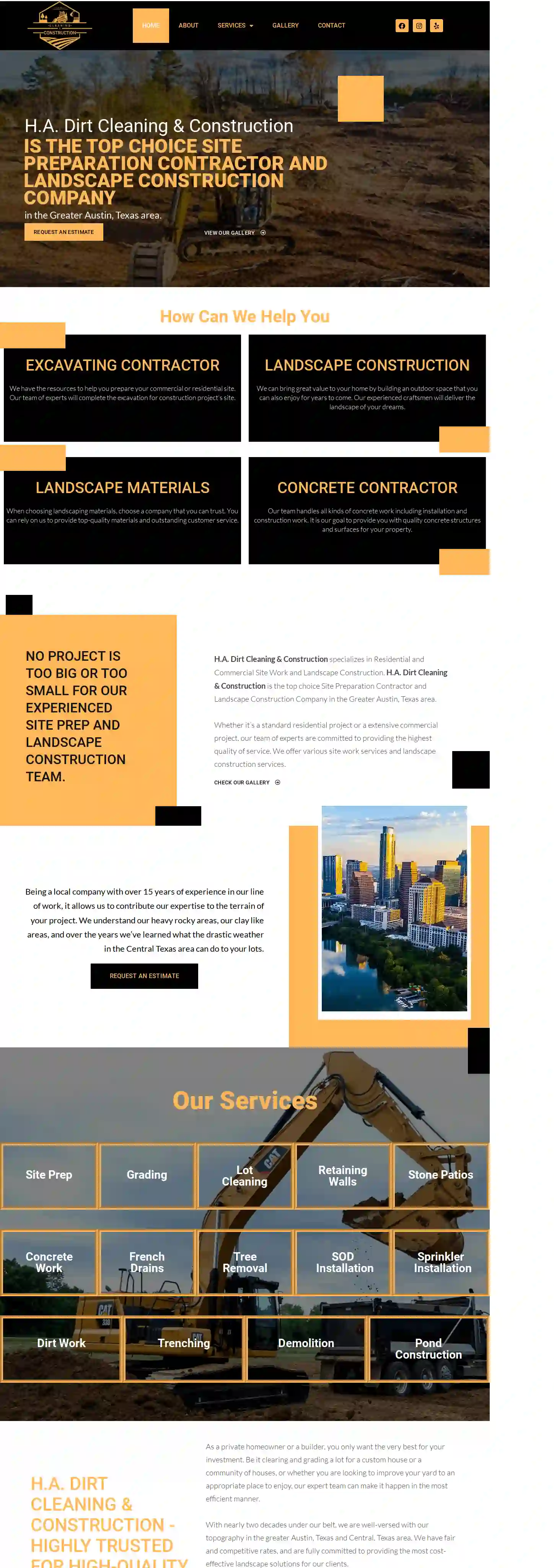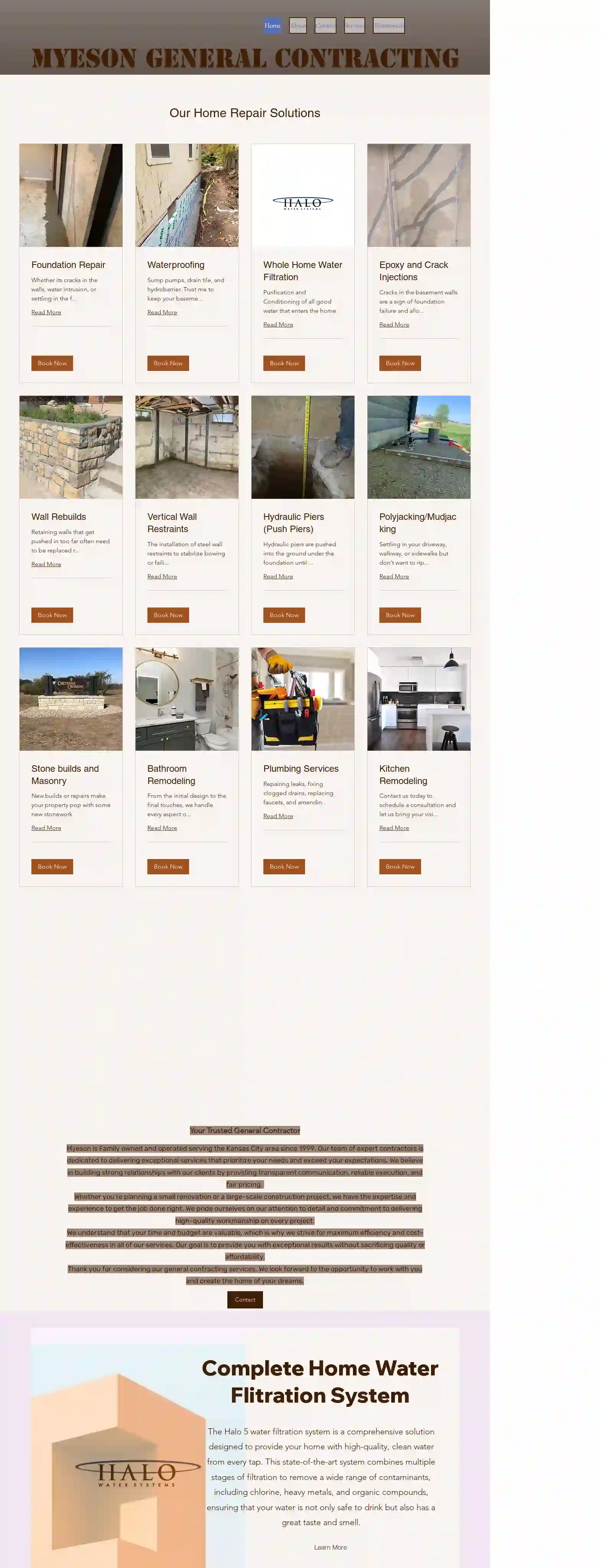Excavation Contractors Mineral Wells
Top 10 Excavation Contractors Near Me in Mineral Wells
Get multiple Excavation Contractor quotes for your project today! Compare profiles, reviews, accreditations, portfolio, etc... and choose the best service.

Poughkeepsie Environmental & Construction Group
55 reviews2600 South Rd, suite 44-156, 2600 South Rd suite 44-156, Poughkeepsie, 12601, USPoughkeepsie Environmental & Construction Group: Your Trusted Partner for Environmental Solutions Since 1994, Poughkeepsie Environmental & Construction Group has been a leading provider of comprehensive environmental services in the Hudson Valley. We are committed to delivering expert solutions that protect your health, safety, and the environment. Our team of highly trained and certified professionals is dedicated to providing exceptional service and exceeding your expectations. We offer a wide range of services, including: • **Testing:** Asbestos, Mold, Radon, VOCs, Lead Paint, Soil, Indoor Air Quality, Phase I, II & III Environmental Surveys, Building Diagnostics, Virus Cleanliness Testing • **Abatement:** Asbestos, Mold, Radon, Lead Paint, Soil Remediation, Hazardous Waste Removal, Virus Disinfection • **Removal:** Building Demolition, Barn Demolition, Pool Fill-In, Tank Removal, Concrete Recycling, Excavation & Drainage • **Demolition:** Building Demolition, Barn Demolition, Pool Fill-In, Tank Removal, Concrete Recycling, Excavation & Drainage • **Disposal:** Hazardous Waste Removal, Concrete Recycling • **Restoration:** Fire/Storm/Water Restoration, Indoor Air Purification, Air Duct Cleaning, Waterproofing, Building Performance, Media Blasting • **Construction:** Building Performance, Media Blasting We are proud to be a trusted partner for businesses and homeowners throughout the Hudson Valley. Our commitment to quality, safety, and customer satisfaction has earned us a reputation for excellence. We are also proud to be a Better Business Bureau Accredited business, a Home Advisor Screened Professional, a Thumbtack Gold Member, an Angie's List Contractor, and a National & State Licensed Contractor. Contact us today to learn more about our services and how we can help you achieve your environmental goals.
- Services
- Why Us?
- Testimonials
- Gallery
Get Quote
Rayco Excavation & Construction
52 reviewsCaddo Mills, USAbout Rayco Excavation & Construction Rayco Excavation & Construction is a professional & experienced land clearing & construction company that is located in Caddo Mills, TX. We provide our clients with a wide range of services including, but not limited to: excavation, land clearing, general construction, grading, site prep & more. Our company works with commercial, residential, & government clients, providing quality services and premier customer service on every project. To learn more about what Rayco Excavation & Construction has to offer, please select from one of the following options: (214) 708-1206 Request a Free Quote
- Services
- Why Us?
- Gallery
Get Quote
H.A. Dirt Cleaning & Construction
511 reviewsAustin, USH.A. Dirt Cleaning & Construction is the top choice Site Preparation Contractor and Landscape Construction Company in the Greater Austin, Texas area. H.A. Dirt Cleaning & Construction specializes in Residential and Commercial Site Work and Landscape Construction. Whether it’s a standard residential project or a extensive commercial project, our team of experts are committed to providing the highest quality of service. We offer various site work services and landscape construction services. Being a local company with over 15 years of experience in our line of work, it allows us to contribute our expertise to the terrain of your project. We understand our heavy rocky areas, our clay like areas, and over the years we’ve learned what the drastic weather in the Central Texas area can do to your lots. As a private homeowner or a builder, you only want the very best for your investment. Be it clearing and grading a lot for a custom house or a community of houses, or whether you are looking to improve your yard to an appropriate place to enjoy, our expert team can make it happen in the most efficient manner. With nearly two decades under our belt, we are well-versed with our topography in the greater Austin, Texas and Central, Texas area. We have fair and competitive rates, and are fully committed to providing the most cost-effective landscape solutions for our clients. You can rest assured that your project will be completed in a timely manner and with professionalism and outstanding customer service. No project is too big or too small for our experienced site prep and landscape construction team.
- Services
- Why Us?
- Gallery
Get Quote
Hammers Construction, Inc.
5103 reviews1411 Woolsey Heights, Colorado Springs, 80915, USDesign-Build Construction Company in Denver and Colorado Springs Hammers Construction is a design-build construction company serving Denver and Colorado Springs. We specialize in residential and commercial construction projects, from small renovations to large-scale developments. Our team of experienced professionals is committed to providing our clients with the highest quality construction services, on time and within budget. We understand that building a new home or business is a major investment. That's why we take a collaborative approach to every project, working closely with our clients to ensure that their vision is realized. We are committed to providing our clients with a seamless and stress-free construction experience. We are a full-service construction company, offering a wide range of services, including: Design-build services Project management Construction management General contracting Subcontracting Remodeling Additions New construction We are committed to providing our clients with the highest quality construction services, on time and within budget. We are also committed to providing a safe and healthy work environment for our employees and subcontractors.
- Services
- Why Us?
- Gallery
Get Quote
Level Up KC Foundation Repair & Excavation
4.945 reviews5565 Cumberland Rd, Odessa, 64076, USTake your home to the next level. Welcome to LEVEL UP FOUNDATION REPAIR, EXCAVATION AND CONTRACTING, LLC, a family-owned business. We provide top-quality foundation repair, excavation, and home improvement services for Kansas City and the surrounding areas. Offering over 15 years of experience, we are fully prepared to offer exceptional and professional services while at an acceptable rate. We offer services from foundation leveling to basement waterproofing along with trenching, gravel hauling, decks, and fencing. Call us today to see how much you can save on your next project or contracting needs. -- JOHNNA AND BRANDON DEAN Odessa, Missouri CALL TODAY
- Services
- Why Us?
- Gallery
Get Quote
RR Excavating & Demolition LLC
54 reviewsAllen, USAbout RR Excavating RR Excavating is a family-owned and operated business with over 20 years of experience in the excavating industry. We are committed to providing our clients with high-quality services at competitive prices. We specialize in a wide range of excavating services, including: Site preparation Grading Demolition Foundation work Utility installation And more! We are fully licensed and insured, and we have a team of experienced and qualified professionals who are dedicated to providing our clients with the best possible service. We are also committed to safety and environmental responsibility. We use the latest equipment and techniques to ensure that our projects are completed on time and within budget. If you are looking for a reliable and experienced excavating contractor, contact RR Excavating today for a free estimate.
- Services
- Why Us?
- Gallery
Get Quote
Myeson General Contracting
518 reviewsHouston, USYour Trusted General Contractor Myeson is Family owned and operated serving the Kansas City area since 1999. Our team of expert contractors is dedicated to delivering exceptional services that prioritize your needs and exceed your expectations. We believe in building strong relationships with our clients by providing transparent communication, reliable execution, and fair pricing. Whether you're planning a small renovation or a large-scale construction project, we have the expertise and experience to get the job done right. We pride ourselves on our attention to detail and commitment to delivering high-quality workmanship on every project. We understand that your time and budget are valuable, which is why we strive for maximum efficiency and cost-effectiveness in all of our services. Our goal is to provide you with exceptional results without sacrificing quality or affordability. Thank you for considering our general contracting services. We look forward to the opportunity to work with you and create the home of your dreams.
- Services
- Why Us?
- Gallery
Get Quote
Blue Moon Hauling
4.79 reviews13402 North Virginia Avenue, Smithville, 64089, USBlue Moon Hauling & Excavation: Your Trusted Partner for Site Work Centrally located in Smithville, Missouri, Blue Moon Hauling and Excavation LLC has been providing competitively priced, professional, and timely service to our clients and construction partners for over two decades. We're experts in excavation and hauling, and our knowledge can make the difference between a successful project and a costly one. We're fully bonded and licensed, and our goal is to keep your project moving efficiently with quality, safety, and the bottom line in mind. Meet Joel Krull, Owner and Founder Joel Krull, the owner and founder of Blue Moon Hauling, brings over 12 years of experience as a Field Superintendent on large commercial projects to the table. He's a member of the Kansas City Builders' Association, has completed the Army Corp of Engineers Supervisory Training Program, and is certified by the U.S. Army Corp of Engineers as a Quality Construction Manager. Blue Moon Hauling has been in business since 1998, starting as a trucking company and expanding to encompass all aspects of site work. We perform building demolition, site demolition, clearing & grubbing, mass excavation, grading, site water utilities, site storm utilities, and site sanitary utilities. We work with both the commercial and municipality sectors, contracting as both a general contractor and a sub-contractor. Our team of operators, laborers, and office staff are dedicated to delivering quality, safety, and efficiency on every project.
- Services
- Why Us?
- Gallery
Get Quote
Roto-Rooter Plumbing & Water Cleanup
4.8612 reviewsPlano, USPlano's Trusted Plumbing, Drain & Water Cleanup Company Looking for residential or commercial plumbing, drain, and water cleanup services in Plano, Texas? Roto-Rooter has been trusted and recommended as a premier plumbing company since 1935, serving customers in Plano and the greater Dallas-Fort Worth Metroplex. Our highly skilled plumbers in Plano, TX, provide full-service maintenance, repair, replacement, and installation of water filtration systems, toilets, garbage disposals, sewer pipes, water heaters, hose bibs, gas lines, and more, working to meet the endless needs of the area’s customers. We know that you need a fully insured, fully licensed service that can efficiently resolve all your plumbing, drainage, or water cleanup needs at any time of the day or night. That’s why Roto-Rooter offers: Same day service 24/7 availability Fully licensed, insured, experienced plumbers State-of-the-art diagnostics and equipment Senior and military discounts Special financing options available Need an appointment? Call our Plano, TX, plumbing office at 972-890-0695, or use our online scheduling tool.
- Services
- Why Us?
- Testimonials
- Gallery
Get Quote
Associated Services
51 reviewsCorpus Christi, USINTRODUCING ASSOCIATED SERVICES Top Quality Guaranteed We provide leading customized tree, lawn and structural maintenance services to our clients and other contractors! We pride ourselves on top quality service and customer satisfaction. Our clients have a wide range of needs. From clearing storm damage, mowing lawns, to grinding a chinaberry stump out of the flower bed! Having a lot of experience in a diverse set of projects . We often can come up with an affordable solution to almost every need. We offer complete flexibility in any project and want to exceed your vision of a project well done. For your next challenge to become a reality. Reach out to us with any questions – we look forward to hearing from you!
- Services
- Why Us?
- Gallery
Get Quote
Over 22,076+ Excavation Businesses in our network
Our excavation providers operate in Mineral Wells and surroundings!
ExcavationHQ has curated and vetted the Best Excavation Pros in and around Mineral Wells. Find a trustworthy pro today.
Frequently Asked Questions About Excavation Contractors
- Determining Soil Suitability: Assessing whether the soil can support the intended structure or load.
- Recommending Foundation Types: Advising on the appropriate foundation design based on soil characteristics.
- Addressing Drainage and Erosion Issues: Providing solutions to manage water runoff and prevent erosion.
- Evaluating Slope Stability: Assessing the risk of landslides or soil movement on slopes.
- Building on challenging soil types (expansive clay, loose sand, etc.)
- Constructing large or complex structures
- Excavating near slopes or retaining walls
- Addressing drainage or erosion concerns
- Utility Locates: Contact your utility companies to mark the locations of underground lines before excavation begins. This is usually a free service.
- Hand Digging: Excavate carefully by hand near marked utility lines to avoid damage.
- Potholing: Digging small test holes to expose and verify utility depths and locations.
- Safe Distances: Maintaining a safe distance between excavation equipment and marked utility lines.
- Vacuum Excavation: Using vacuum excavation techniques to expose utilities without digging, reducing the risk of damage.
- Basement Size: The larger the basement, the more excavation is required, increasing the cost.
- Soil Type: Excavating rocky or dense clay soil is generally more expensive than loose soil.
- Accessibility: Difficult-to-access sites might require specialized equipment or more labor, driving up costs.
- Foundation Type: The chosen foundation type (full basement, crawl space, slab) affects excavation needs.
- Underpinning: If underpinning (strengthening existing foundations) is necessary, it significantly increases costs.
- Disposal Fees: Hauling excavated soil to disposal sites adds to the overall expense.
- Soil Type and Stability: Stable, cohesive soils allow for deeper excavations than loose or unstable soils.
- Groundwater Level: Excavations below the water table require dewatering techniques to manage water intrusion.
- Equipment and Resources: The size and capabilities of excavation equipment influence the achievable depth.
- Safety Regulations: OSHA and other safety regulations impose limitations on trench depths without proper shoring or sloping.
- Project Requirements: The purpose of the excavation (basement, pool, foundation) determines the necessary depth.
What is a soil engineer, and do I need one?
How do you protect utilities during excavation?
How much does it cost to excavate a basement?
How deep can you excavate?
What is a soil engineer, and do I need one?
- Determining Soil Suitability: Assessing whether the soil can support the intended structure or load.
- Recommending Foundation Types: Advising on the appropriate foundation design based on soil characteristics.
- Addressing Drainage and Erosion Issues: Providing solutions to manage water runoff and prevent erosion.
- Evaluating Slope Stability: Assessing the risk of landslides or soil movement on slopes.
- Building on challenging soil types (expansive clay, loose sand, etc.)
- Constructing large or complex structures
- Excavating near slopes or retaining walls
- Addressing drainage or erosion concerns
How do you protect utilities during excavation?
- Utility Locates: Contact your utility companies to mark the locations of underground lines before excavation begins. This is usually a free service.
- Hand Digging: Excavate carefully by hand near marked utility lines to avoid damage.
- Potholing: Digging small test holes to expose and verify utility depths and locations.
- Safe Distances: Maintaining a safe distance between excavation equipment and marked utility lines.
- Vacuum Excavation: Using vacuum excavation techniques to expose utilities without digging, reducing the risk of damage.
How much does it cost to excavate a basement?
- Basement Size: The larger the basement, the more excavation is required, increasing the cost.
- Soil Type: Excavating rocky or dense clay soil is generally more expensive than loose soil.
- Accessibility: Difficult-to-access sites might require specialized equipment or more labor, driving up costs.
- Foundation Type: The chosen foundation type (full basement, crawl space, slab) affects excavation needs.
- Underpinning: If underpinning (strengthening existing foundations) is necessary, it significantly increases costs.
- Disposal Fees: Hauling excavated soil to disposal sites adds to the overall expense.
How deep can you excavate?
- Soil Type and Stability: Stable, cohesive soils allow for deeper excavations than loose or unstable soils.
- Groundwater Level: Excavations below the water table require dewatering techniques to manage water intrusion.
- Equipment and Resources: The size and capabilities of excavation equipment influence the achievable depth.
- Safety Regulations: OSHA and other safety regulations impose limitations on trench depths without proper shoring or sloping.
- Project Requirements: The purpose of the excavation (basement, pool, foundation) determines the necessary depth.